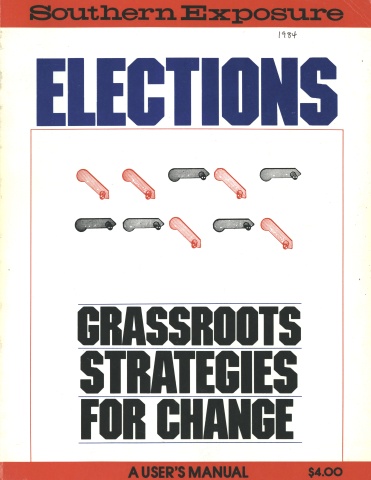How To: Rate the Runners

This article originally appeared in Southern Exposure Vol. 12 No. 1, "Elections: Grassroots Strategies for Change." Find more from that issue here.
Put aside all thoughts of smoke-filled rooms and whispered hallway deals and look at the bright side. Not nearly all, but a great deal, of what your elected lawmakers do to represent you is done in the bright light of day, in public, on the record. This includes voting on bills, resolutions, amendments, and motions, and if you know how to use the available records, you can get a good picture of where your elected officials stand on the issues that concern you. And that will help you decide whether you want to see them re-elected — or what issues your own candidates can challenge them on.
Dozens of national organizations compile the voting records of U.S. senators and representatives — we put some of them to use in the article on page 11. Some are all-purpose ratings compiled by political groups at various points from left to right on the political spectrum. The litmus test for orthodox liberals, for example, is administered by Americans for Democratic Action. Its counterpart on the right is Americans for Constitutional Action. Other ratings reflect a member's position on issues of special concern to particular interest groups. For organized labor, for example, there is the AFL-CIO's Committee on Political Education; for feminists, the National Women's Political Caucus; for family farmers, the National Farmers Union; for environmentalists, the League of Conservation Voters; for militarists, the American Security Index; and so on.
You can get copies by writing the groups, or you can go to the public library and find the Almanac of American Politics or Congressional Quarterly Weekly Report. The Almanac, published every other year, includes the ratings of 10 groups and also chooses 15 key votes itself, designed to show how each member voted on major issues of current interest. And CQ does an annual listing of ratings by eight organizations, some of them different from the Almanac's. Rather than try to rate members of Congress yourself, you'll probably find everything you need to know from these sources.
Knowing what your state legislators are up to is another matter. Doing a rating is a time-consuming chore, and most state-level groups don't have — or don't think they have — the resources to do one. But state legislatures are important; they make decisions that affect as many aspects of life as Congress does. They may not have the power to send aid to El Salvador, deregulate natural gas, build a dam or a breeder reactor, or vote money for nuclear war. But they can raise your insurance rates, charge a sales tax on food, kill the ERA, spend your money on highways instead of day care, or build prisons instead of schools. What they do affects you every day.
How do you choose which votes will tell you who is and isn't on your side? First you must determine what legislation is important to your group; probably there are measures you'd like to pass and measures you'd like to kill. Then you must figure out which record votes are the best indicators of a legislator's position on the measures. This is the critical step — and the hardest to get right, because politicians can be sneaky about putting their real sentiments on the record.
The vote on final passage of a bill is rarely the one that tells you which legislators were there when you needed them most. By then the fate of the bill is usually known, and if either side is winning by a wide margin, several legislators may switch sides, depending on how they want their constituents to think they voted. Typically, you will find the real test of a lawmaker's position is his or her vote on a procedural motion or a floor amendment to the bill.
For example, say you are opposed to a newly introduced bill that will seriously weaken the state attorney general's consumer protection powers. It is late in the session, and a new bill can't be voted on unless two-thirds of the members vote to suspend the rules. They do, and the bill eventually passes by a small majority. That vote to suspend the rules is what killed you, and that's the one to pick.
Or let's say you want to pass a bill giving the attorney general strong consumer protection powers. It eventually passes, but not before the business lobby has eaten away at it with amendments, leaving an empty shell that tells the attorney general to protect consumers but doesn't give him or her the power to do it. You pick the votes on the most damaging amendments.
If you've been at the capitol all along lobbying for your cause, you'll know which votes were the critical ones — and you'll know which legislators gave strong support and which simply voted correctly. If you haven't been at the capitol, you must talk to people who were there, both lobbyists and friendly legislators. You'll never figure out what went on just by reading the legislative journals or daily press.
Once you've picked the votes, you can draw up a chart listing how each member's stand matches your view of the correct vote — positive, negative, or absent. You can then compute each legislator's percentage of correct votes to give her or his rating: nine votes that match your positions out of 14 in the sample yield a rating of 64. Come the next election, you won't have to take the incumbent's word for how she or he represents you; you'll have facts.
Tags
Linda Rocawich
Linda Rocawich, 37, is an editor of Southern Exposure. (1985)
Linda Rocawich, a Southern Exposure editor, lived in Lloyd Doggett’s Texas Senate district for eight years. (1984)